Pengfei Sun
EEG decoding with conditional identification information
Mar 21, 2024Abstract:Decoding EEG signals is crucial for unraveling human brain and advancing brain-computer interfaces. Traditional machine learning algorithms have been hindered by the high noise levels and inherent inter-person variations in EEG signals. Recent advances in deep neural networks (DNNs) have shown promise, owing to their advanced nonlinear modeling capabilities. However, DNN still faces challenge in decoding EEG samples of unseen individuals. To address this, this paper introduces a novel approach by incorporating the conditional identification information of each individual into the neural network, thereby enhancing model representation through the synergistic interaction of EEG and personal traits. We test our model on the WithMe dataset and demonstrated that the inclusion of these identifiers substantially boosts accuracy for both subjects in the training set and unseen subjects. This enhancement suggests promising potential for improving for EEG interpretability and understanding of relevant identification features.
Delayed Memory Unit: Modelling Temporal Dependency Through Delay Gate
Oct 23, 2023Abstract:Recurrent Neural Networks (RNNs) are renowned for their adeptness in modeling temporal dependencies, a trait that has driven their widespread adoption for sequential data processing. Nevertheless, vanilla RNNs are confronted with the well-known issue of gradient vanishing and exploding, posing a significant challenge for learning and establishing long-range dependencies. Additionally, gated RNNs tend to be over-parameterized, resulting in poor network generalization. To address these challenges, we propose a novel Delayed Memory Unit (DMU) in this paper, wherein a delay line structure, coupled with delay gates, is introduced to facilitate temporal interaction and temporal credit assignment, so as to enhance the temporal modeling capabilities of vanilla RNNs. Particularly, the DMU is designed to directly distribute the input information to the optimal time instant in the future, rather than aggregating and redistributing it over time through intricate network dynamics. Our proposed DMU demonstrates superior temporal modeling capabilities across a broad range of sequential modeling tasks, utilizing considerably fewer parameters than other state-of-the-art gated RNN models in applications such as speech recognition, radar gesture recognition, ECG waveform segmentation, and permuted sequential image classification.
Adaptive Axonal Delays in feedforward spiking neural networks for accurate spoken word recognition
Feb 16, 2023Abstract:Spiking neural networks (SNN) are a promising research avenue for building accurate and efficient automatic speech recognition systems. Recent advances in audio-to-spike encoding and training algorithms enable SNN to be applied in practical tasks. Biologically-inspired SNN communicates using sparse asynchronous events. Therefore, spike-timing is critical to SNN performance. In this aspect, most works focus on training synaptic weights and few have considered delays in event transmission, namely axonal delay. In this work, we consider a learnable axonal delay capped at a maximum value, which can be adapted according to the axonal delay distribution in each network layer. We show that our proposed method achieves the best classification results reported on the SHD dataset (92.45%) and NTIDIGITS dataset (95.09%). Our work illustrates the potential of training axonal delays for tasks with complex temporal structures.
Spikemax: Spike-based Loss Methods for Classification
May 19, 2022



Abstract:Spiking Neural Networks~(SNNs) are a promising research paradigm for low power edge-based computing. Recent works in SNN backpropagation has enabled training of SNNs for practical tasks. However, since spikes are binary events in time, standard loss formulations are not directly compatible with spike output. As a result, current works are limited to using mean-squared loss of spike count. In this paper, we formulate the output probability interpretation from the spike count measure and introduce spike-based negative log-likelihood measure which are more suited for classification tasks especially in terms of the energy efficiency and inference latency. We compare our loss measures with other existing alternatives and evaluate using classification performances on three neuromorphic benchmark datasets: NMNIST, DVS Gesture and N-TIDIGITS18. In addition, we demonstrate state of the art performances on these datasets, achieving faster inference speed and less energy consumption.
NTIRE 2021 Challenge on Perceptual Image Quality Assessment
May 11, 2021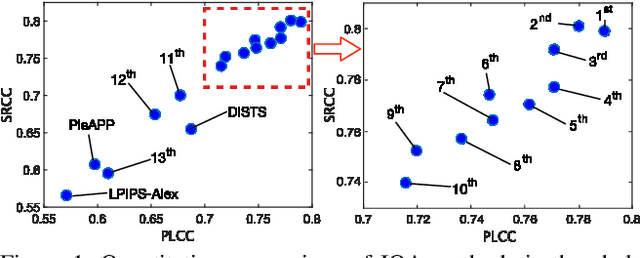
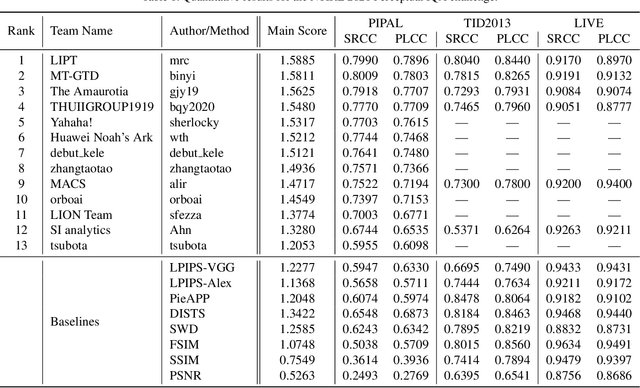
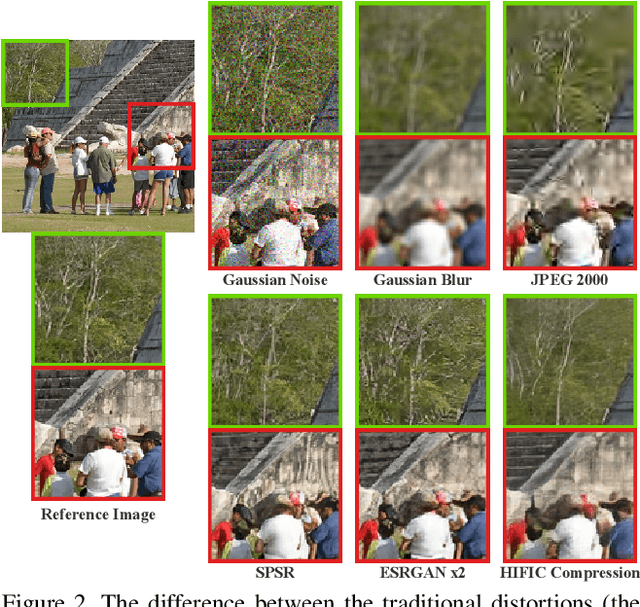
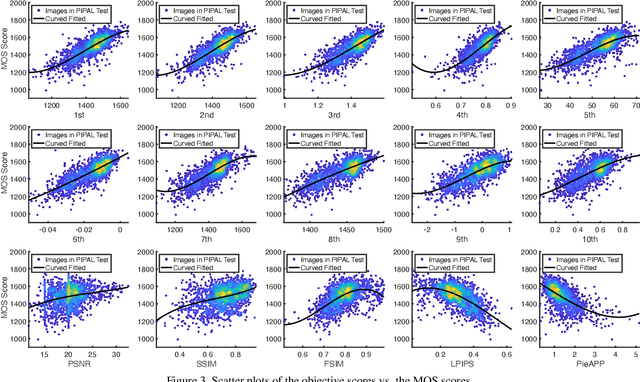
Abstract:This paper reports on the NTIRE 2021 challenge on perceptual image quality assessment (IQA), held in conjunction with the New Trends in Image Restoration and Enhancement workshop (NTIRE) workshop at CVPR 2021. As a new type of image processing technology, perceptual image processing algorithms based on Generative Adversarial Networks (GAN) have produced images with more realistic textures. These output images have completely different characteristics from traditional distortions, thus pose a new challenge for IQA methods to evaluate their visual quality. In comparison with previous IQA challenges, the training and testing datasets in this challenge include the outputs of perceptual image processing algorithms and the corresponding subjective scores. Thus they can be used to develop and evaluate IQA methods on GAN-based distortions. The challenge has 270 registered participants in total. In the final testing stage, 13 participating teams submitted their models and fact sheets. Almost all of them have achieved much better results than existing IQA methods, while the winning method can demonstrate state-of-the-art performance.
GLMNet: Graph Learning-Matching Networks for Feature Matching
Nov 18, 2019



Abstract:Recently, graph convolutional networks (GCNs) have shown great potential for the task of graph matching. It can integrate graph node feature embedding, node-wise affinity learning and matching optimization together in a unified end-to-end model. One important aspect of graph matching is the construction of two matching graphs. However, the matching graphs we feed to existing graph convolutional matching networks are generally fixed and independent of graph matching, which thus are not guaranteed to be optimal for the graph matching task. Also, existing GCN matching method employs several general smoothing-based graph convolutional layers to generate graph node embeddings, in which extensive smoothing convolution operation may dilute the desired discriminatory information of graph nodes. To overcome these issues, we propose a novel Graph Learning-Matching Network (GLMNet) for graph matching problem. GLMNet has three main aspects. (1) It integrates graph learning into graph matching which thus adaptively learn a pair of optimal graphs that best serve graph matching task. (2) It further employs a Laplacian sharpening convolutional module to generate more discriminative node embeddings for graph matching. (3) A new constraint regularized loss is designed for GLMNet training which can encode the desired one-to-one matching constraints in matching optimization. Experiments on two benchmarks demonstrate the effectiveness of GLMNet and advantages of its main modules.
Brain2Char: A Deep Architecture for Decoding Text from Brain Recordings
Sep 03, 2019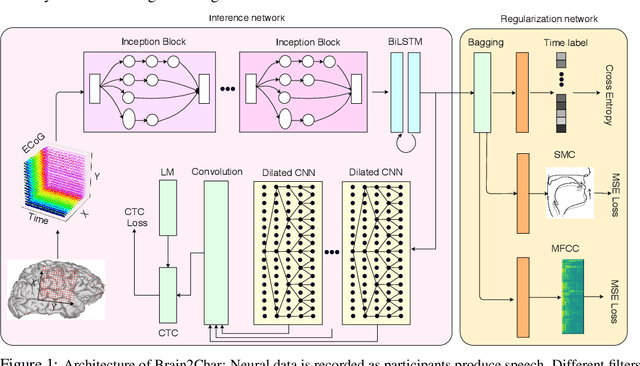

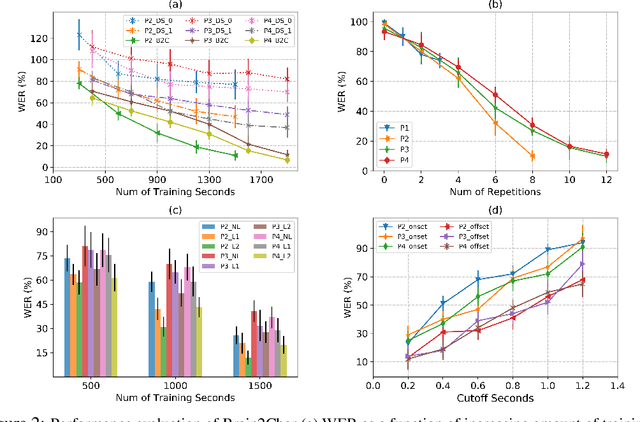
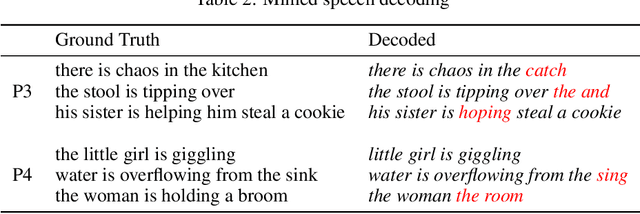
Abstract:Decoding language representations directly from the brain can enable new Brain-Computer Interfaces (BCI) for high bandwidth human-human and human-machine communication. Clinically, such technologies can restore communication in people with neurological conditions affecting their ability to speak. In this study, we propose a novel deep network architecture Brain2Char, for directly decoding text (specifically character sequences) from direct brain recordings (called Electrocorticography, ECoG). Brain2Char framework combines state-of-the-art deep learning modules --- 3D Inception layers for multiband spatiotemporal feature extraction from neural data and bidirectional recurrent layers, dilated convolution layers followed by language model weighted beam search to decode character sequences, optimizing a connectionist temporal classification (CTC) loss. Additionally, given the highly non-linear transformations that underlie the conversion of cortical function to character sequences, we perform regularizations on the network's latent representations motivated by insights into cortical encoding of speech production and artifactual aspects specific to ECoG data acquisition. To do this, we impose auxiliary losses on latent representations for articulatory movements, speech acoustics and session specific non-linearities. In 3 participants tested here, Brain2Char achieves 10.6\%, 8.5\% and 7.0\% Word Error Rates (WER) respectively on vocabulary sizes ranging from 1200 to 1900 words. Brain2Char also performs well when 2 participants silently mimed sentences. These results set a new state-of-the-art on decoding text from brain and demonstrate the potential of Brain2Char as a high-performance communication BCI.
Modeling neural dynamics during speech production using a state space variational autoencoder
Jan 13, 2019



Abstract:Characterizing the neural encoding of behavior remains a challenging task in many research areas due in part to complex and noisy spatiotemporal dynamics of evoked brain activity. An important aspect of modeling these neural encodings involves separation of robust, behaviorally relevant signals from background activity, which often contains signals from irrelevant brain processes and decaying information from previous behavioral events. To achieve this separation, we develop a two-branch State Space Variational AutoEncoder (SSVAE) model to individually describe the instantaneous evoked foreground signals and the context-dependent background signals. We modeled the spontaneous speech-evoked brain dynamics using smoothed Gaussian mixture models. By applying the proposed SSVAE model to track ECoG dynamics in one participant over multiple hours, we find that the model can predict speech-related dynamics more accurately than other latent factor inference algorithms. Our results demonstrate that separately modeling the instantaneous speech-evoked and slow context-dependent brain dynamics can enhance tracking performance, which has important implications for the development of advanced neural encoding and decoding models in various neuroscience sub-disciplines.
Enhanced Factored Three-Way Restricted Boltzmann Machines for Speech Detection
Apr 20, 2017



Abstract:In this letter, we propose enhanced factored three way restricted Boltzmann machines (EFTW-RBMs) for speech detection. The proposed model incorporates conditional feature learning by multiplying the dynamical state of the third unit, which allows a modulation over the visible-hidden node pairs. Instead of stacking previous frames of speech as the third unit in a recursive manner, the correlation related weighting coefficients are assigned to the contextual neighboring frames. Specifically, a threshold function is designed to capture the long-term features and blend the globally stored speech structure. A factored low rank approximation is introduced to reduce the parameters of the three-dimensional interaction tensor, on which non-negative constraint is imposed to address the sparsity characteristic. The validations through the area-under-ROC-curve (AUC) and signal distortion ratio (SDR) show that our approach outperforms several existing 1D and 2D (i.e., time and time-frequency domain) speech detection algorithms in various noisy environments.
Neural networks based EEG-Speech Models
Mar 31, 2017



Abstract:In this paper, we propose an end-to-end neural network (NN) based EEG-speech (NES) modeling framework, in which three network structures are developed to map imagined EEG signals to phonemes. The proposed NES models incorporate a language model based EEG feature extraction layer, an acoustic feature mapping layer, and a restricted Boltzmann machine (RBM) based the feature learning layer. The NES models can jointly realize the representation of multichannel EEG signals and the projection of acoustic speech signals. Among three proposed NES models, two augmented networks utilize spoken EEG signals as either bias or gate information to strengthen the feature learning and translation of imagined EEG signals. Experimental results show that all three proposed NES models outperform the baseline support vector machine (SVM) method on EEG-speech classification. With respect to binary classification, our approach achieves comparable results relative to deep believe network approach.
 Add to Chrome
Add to Chrome Add to Firefox
Add to Firefox Add to Edge
Add to Edge